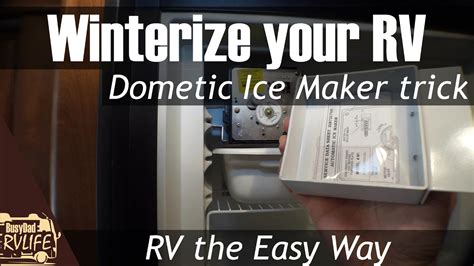How To Winterize An Rv Ice Maker
Ronan Farrow
Apr 03, 2025 · 3 min read

Table of Contents
How to Winterize Your RV Ice Maker: A Complete Guide
Winterizing your RV is crucial to prevent costly damage from freezing temperatures. While many focus on plumbing and tanks, the ice maker often gets overlooked. Ignoring your ice maker during winterization can lead to cracked lines, a malfunctioning machine, and expensive repairs. This comprehensive guide will walk you through the simple steps to properly winterize your RV ice maker and protect your investment.
Understanding the Risks of Freezing
Before we dive into the how-to, let's understand why winterizing your ice maker is so important. Water expands when it freezes. This expansion can exert immense pressure on the internal components of your ice maker, leading to:
- Cracked water lines: These are often the first casualties of freezing temperatures. Repairing or replacing them can be costly and time-consuming.
- Damaged ice maker components: The pressure from expanding ice can damage the internal mechanisms of the ice maker itself, rendering it unusable.
- Mold and mildew growth: Standing water inside the ice maker provides an ideal breeding ground for mold and mildew, leading to unpleasant odors and potential health problems.
Step-by-Step Winterization Process
Now, let's get to the practical steps involved in winterizing your RV ice maker. These steps are generally applicable to most RV ice makers, but always refer to your owner's manual for model-specific instructions.
1. Turn Off the Water Supply
The first and most important step is to completely shut off the water supply to your RV ice maker. This usually involves turning off the valve located near the water inlet line. This prevents any further water from entering the system.
2. Disconnect the Water Line
Carefully disconnect the water line from the ice maker. This allows you to drain any remaining water from the line and the ice maker itself.
3. Drain the Water Line
With the line disconnected, drain any remaining water from the line. You can do this by tilting the line slightly to allow the water to flow out. A small amount of residual water might remain, but that's okay.
4. Purge the Ice Maker
Most RV ice makers have a small drain line. If yours does, use it to purge any remaining water inside the machine. You may need to refer to your user manual to locate the drain line.
5. Dry the Components
Thoroughly dry all the components you've disconnected. Use a clean cloth or towel to wipe away any moisture. This helps prevent the growth of mold and mildew during storage.
6. Blow Air Through the Line (Optional but Recommended)
For added protection, consider using an air compressor to blow compressed air through the water line. This will help remove any lingering moisture.
Maintaining Your RV Ice Maker for a Smooth Spring Restart
Once you've completed the winterization process, store your RV ice maker in a cool, dry place. When spring arrives, simply reverse the steps:
- Reconnect the water line.
- Turn on the water supply.
- Run a few cycles to ensure everything is working properly.
By following these simple steps, you can ensure your RV ice maker is protected from freezing temperatures and ready for use when the warmer months return.
Keywords for SEO:
RV ice maker winterization, winterize RV ice maker, RV ice maker freezing, protect RV ice maker winter, how to winterize RV ice maker, RV winterizing tips, winterizing your RV, prevent RV ice maker damage, RV maintenance winter.
Remember to always consult your RV and ice maker's owner's manual for specific instructions and recommendations.
Featured Posts
Also read the following articles
| Article Title | Date |
|---|---|
| 1189 Howe St Vancouver | Apr 03, 2025 |
| Can Kindle Tell Me How Fast I Read | Apr 03, 2025 |
| How Are Little League All Stars Chosen | Apr 03, 2025 |
| Howa Carbon Elevate 6mm Arc | Apr 03, 2025 |
| How Can I Become A Midwife Assistant | Apr 03, 2025 |
Latest Posts
-
How Far Away Is The Beach
Apr 04, 2025
-
How Far Away From Screen For Golf Simulator
Apr 04, 2025
-
How Far Away Does Remote Start Work
Apr 04, 2025
-
How Far Away Can Deer Smell Doe Urine
Apr 04, 2025
-
How Far Away Can Deer Smell Apples
Apr 04, 2025
Thank you for visiting our website which covers about How To Winterize An Rv Ice Maker . We hope the information provided has been useful to you. Feel free to contact us if you have any questions or need further assistance. See you next time and don't miss to bookmark.
